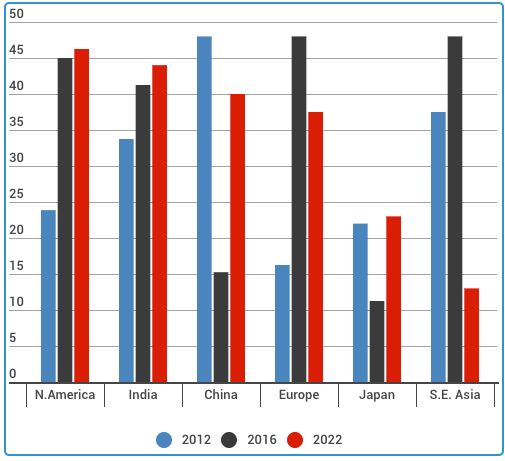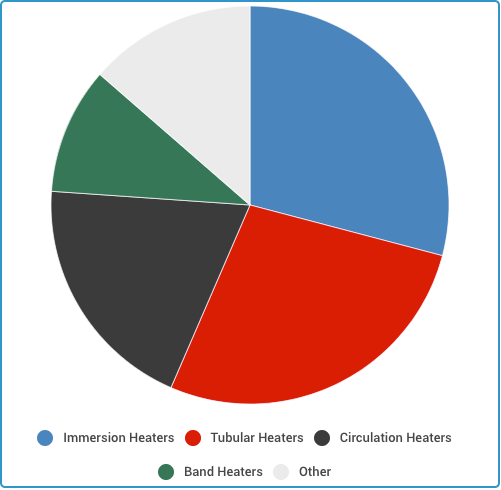Global Electric Heating Elements Continued Growth is Predicted Up to 2025
Last updated on March 1st, 2019 at 09:15 pm
Electric heating elements are in a state of growth. Over the past decade, there has been a significant increase in the production and demand. This trend is predicted to continue up until at least 2025. The latest studies predict an increase in the current global electric heating element market to grow at a rate of 4.52%. That will take them from $8571.0 million (USD) in 2017 to $12208.8 million (USD) in 2025. The predicted growth reflects current and anticipated demands, innovations and needs in key industries.
Electric Heating Elements
Heater elements are a key component of most industrial heating systems. They transfer the energy from the system to provide heating. Their materials are customizable making them ideal for direct heating applications. Resistant materials allow for quick and efficient heating of even corrosive materials. Element shapes are also customizable to maximize efficiency for specific applications. While WATTCO industrial heating elements are built to last, they are also replaceable. That means heaters last longer since there is need to replace the whole system if the elements succumb to wear and tear. Electric heating elements produced for immersion heaters and tubular heaters make up the majority of the globally produced market share.
Global Electric Heating Element Production Share by Heater Type (2017)
Why is Electric Heating Element Production Going to Grow?
The reasoning behind the predicted growth in electric heater element production involves current trends and demands, as well as those anticipated in the near future. Globally, one of the largest causes is an increasing demand for clean energy. There is growing public and governmental pressures for green initiatives. Many governments even offer funding or rebates for companies switching to greener solutions.
The concern for clean energy is only expected to grow. This is leading to a greater demand for electric heating systems. Electricity is a clean, zero-emission energy source. It’s good for the environment, and for public image. In addition to environment and PR benefits, there are a number of advantages to electrical heating. Cost is one of the largest.
The cost of electricity is cheaper than natural fuels, so electric heaters operate at lower costs. They also last longer than heaters powered by combustion. As a result, they cost less in repairs, maintenance, and replacements. Electricity is also a more efficient power source. Electric heater elements can reach higher temperatures faster and with greater accuracy. When coupled with thermocouples and high limit cut offs they offer greater automation, control, and safety as well.
Electric heating technology is evolving more rapidly than it’s natural gas counterparts. In part, this is due to an increasing demand for electricity. The effect is even better electric heating solutions. This increases the demand, and thus pushes technological advancement further. Globally, the demand for industrial heating continues to grow. This is another factor, as it contributes to an increase in the production of all industrial heating elements.
Global Electric Heater Element Growth by Region
 While the global electric heating market is in a state of growth overall, in some regions, it’s expected to decline. The reasons are related to the demands of each region. China, for example, has the most dramatic increase in predicted growth. The main relation to this is a massive program to reduce pollution. China announced a 5-year plan to switch 70% of its cities to cleaner heating.
While the global electric heating market is in a state of growth overall, in some regions, it’s expected to decline. The reasons are related to the demands of each region. China, for example, has the most dramatic increase in predicted growth. The main relation to this is a massive program to reduce pollution. China announced a 5-year plan to switch 70% of its cities to cleaner heating.
China has long used coal power, By converting to cleaner energy they can reduce bulk coal burning by 74 million tonnes by 2019. This switch is going to require a big spike in electric heater element production to satisfy China’s need. Conversely, S.E. Asia is expected to see a dramatic decline in growth.
While China reduces coal consumption, Southeast Asia is increasing their coal demand. Coal is a cheaper alternative to natural gas and coal burning projects require less capital to start than gas or electric heating. Until cleaner solutions can offer more comparable infrastructure costs, regions with less capital to invest in power projects will continue to rely on coal for heating.

